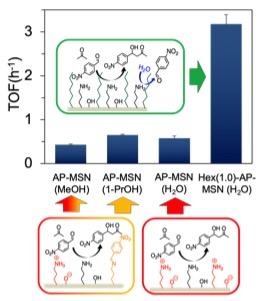
Aminopropyl-functionalized mesoporous silica nanoparticles (AP-MSN) catalyze aldol condensations. The activity of AP-MSN decreases with increasing solvent polarity due to the stabilization of ion pairs formed between acidic silanol groups and the amines, which ultimately decreases the number of catalytically active amine sites. However, the reaction in water is faster than expected on the basis of polarity, because water limits the formation of Schiff bases that are also responsible for blocking active sites. In this work, we combined the action of water with a low-local-polarity environment around the catalytic sites of AP-MSN to maximize active site availability and catalyst performance. We specifically demonstrate how the local polarity of AP-MSN can be controlled by modifying its surface with varying concentrations of hexyl groups and how the dielectric constant of the silica–water interface can be determined using the solvatochromic probe Prodan. The catalytic activities of hexyl-modified AP-MSN in water were inversely proportional to their interfacial dielectric constants and were significantly higher (roughly by a factor of 4) than those of AP-MSN in anhydrous solvents of comparable polarities. Producing low-local-polarity environments in aqueous AP-MSN also enhanced the sensitivity of the aldol reaction to the electronic effects of substituents in the substrate. The enhancement of catalytic activity by low interfacial polarity was also observed in other amine-catalyzed C–C bond forming reactions such as the Henry and vinylogous aldol reactions. Overall, our results demonstrate that the catalytic activity of AP-MSN can be controlled by the synergistic action of water and a low interfacial dielectric constant.
Singappuli, D., Kobayashi, T., Wang, Z., Burkhow, S., Smith, E.A., Pruski, M., Slowing, I.I., Interfacial Control of Catalytic Activity in the Aldol Condensation: Combining the Effects of Hydrophobic Environments and Water, ACS Catal, 2019, 9, 55774-5582.
